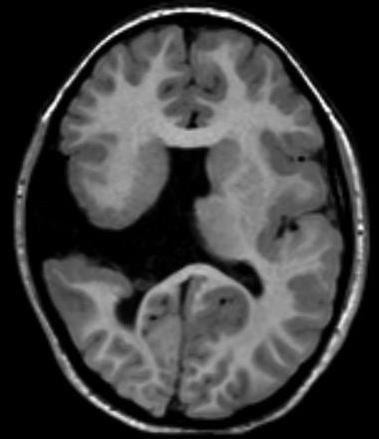Incidence ▒ 1/70,000 births. Sporadic malformation but cases of autosomal dominant or recessive transmission have been described. Abnormality of the cerebral mantle due to the presence of a linear cleft, lined with dysplastic gray matter and containing CSF, which extends from the lateral ventricle to the surface of the cortex (most often frontal or parietal). The anomaly can be uni or bilateral (> 50 %). It is sometimes associated with CMV+ infection, vascular abnormalities, maternal trauma, or exposure to toxics in utero. It seems that mutations of the COL4A1 (13q34), EMX2 (10q26.4), SHH (7q36.3) or SIX3 (2p21) genes may be a susceptibility factor to the effect of external agents.
Schizencephaly can be:
- open (type II: open lip): the subarachnoid spaces communicate with the lateral ventricles.
- closed (type I: closed lip): no communication, 'incomplete cleft'
Sometimes associated: atrophy of the optic nerve, hydrocephalus, microcephaly, absence of the corpus callosum or the septum pellucidum.
Clinical presentations:
- unilateral cleft: hemiparesis, mild motor deficit, epilepsy
- bilateral cleft: severe developmental delay, spasticity, epilepsy.

Anesthetic implications:
complex epilepsy
Referencesá:
-
Updated: September 2021